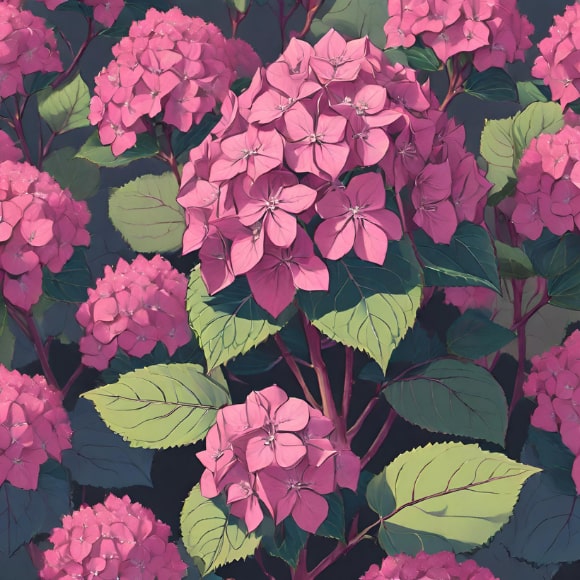
Mountain Hydrangea, also known as lacecap hydrangea, is a delightful and versatile flowering shrub that brings elegance and charm to gardens. Renowned for its lace-like flower clusters, compact size, and exquisite foliage, this deciduous plant is a favorite among gardeners seeking a captivating addition to their landscapes. Understanding the specific requirements and characteristics of Mountain Hydrangea is crucial for cultivating a thriving and visually appealing garden.
Botanical Features
Mountain Hydrangea is a member of the Hydrangeaceae family and is closely related to the more well-known bigleaf hydrangea (Hydrangea macrophylla). Its botanical name, Hydrangea serrata, refers to the serrated edges of its leaves. This hydrangea variety typically grows in a rounded, mounded shape, reaching a height and width of 3 to 5 feet. The serrated, ovate leaves are dark green, providing an attractive backdrop to the delicate lacecap flowers. The lacecap flowers feature a cluster of small, fertile flowers surrounded by larger, sterile flowers, creating a unique and intricate appearance.
Soil Requirements
Mountain Hydrangeas prefer well-draining, organically rich soil with a slightly acidic to neutral pH. Unlike their bigleaf counterparts, the flower color of Mountain Hydrangeas is not significantly affected by soil pH. However, ensuring proper drainage is essential to prevent waterlogged soil, which can lead to root rot. Amending the soil with organic matter, such as compost or well-rotted manure, enhances fertility and moisture retention. Aim for a pH range between 5.5 and 6.5 for optimal growth.
Best Plant Hardiness Zones
Mountain Hydrangeas are well-suited to a range of hardiness zones, making them adaptable to various climates. They generally thrive in USDA hardiness zones 5 to 9. However, it’s crucial to consider local conditions, microclimates, and regional variations within these zones. Factors such as elevation, proximity to large bodies of water, and specific weather patterns can influence the success of Mountain Hydrangeas in a particular location.
Sun Exposure
Mountain Hydrangeas thrive in partial shade to filtered sunlight. While they can tolerate some morning sun, providing protection from the intense afternoon sun is crucial, especially in warmer climates. In regions with cooler temperatures, they can tolerate more sunlight. Striking the right balance between sunlight and shade ensures healthy growth, prevents leaf scorching, and promotes prolific flowering.
Watering Requirements
Proper watering is essential for the health and vitality of Mountain Hydrangea. These plants prefer consistently moist but not waterlogged soil. During the growing season, which typically spans Spring to early Fall, provide regular watering to keep the soil consistently moist. Applying a layer of organic mulch around the base of the plant helps retain moisture, suppress weeds, and regulate soil temperature. However, it’s important to avoid overwatering, as excessive moisture can lead to root issues and fungal diseases.
Maintenance Tips
Mountain Hydrangeas are relatively low-maintenance, but a few key practices can enhance their overall performance and appearance.
Pruning
Regular pruning is beneficial for shaping the plant, removing dead or weak branches, and encouraging new growth. Prune the hydrangea in late Winter or early Spring before new growth emerges. Remove spent flowers to promote continuous blooming.
Fertilization
Apply a balanced, slow-release fertilizer in early Spring to provide essential nutrients for healthy growth and abundant blooms. Follow the manufacturer’s recommendations for application rates based on the size and age of the plant.
Mulching
Apply a 2 to 3-inch layer of organic mulch, such as shredded bark or compost, around the base of the plant. Mulching helps retain moisture, regulate soil temperature, and suppress weeds.
Winter Protection
In colder climates, consider providing Winter protection by covering the base of the plant with a layer of mulch and wrapping the branches with burlap to shield them from harsh Winter winds.
Landscaping Uses
Mountain Hydrangeas offer versatility in landscaping and can be employed in various settings to enhance the beauty of outdoor spaces. Here are some landscaping uses for this captivating hydrangea variety.
Mixed Borders
Plant Mountain Hydrangeas in mixed borders alongside other shrubs, perennials, and ornamental grasses. Their compact size and elegant blooms complement a wide range of companion plants, creating a harmonious and visually appealing display.
Woodland Gardens
Thriving in partial shade, Mountain Hydrangeas are well-suited for woodland garden settings. Combine them with shade-loving plants like hostas, ferns, and astilbes for a natural and enchanting woodland landscape.
Foundation Planting
Use Mountain Hydrangeas in foundation planting to soften the lines of buildings and add a touch of sophistication to the landscape. Their moderate size makes them suitable for planting near entrances or along pathways.
Container Gardening
Grow Mountain Hydrangeas in containers on patios, balconies, or in small gardens. Ensure the containers have drainage holes, use a high-quality potting mix, and water consistently to maintain optimal moisture levels.
Cut Flower Gardens
The lacecap flowers of Mountain Hydrangeas make beautiful additions to cut-flower arrangements. Harvest blooms at their peak and enjoy their delicate beauty indoors.
Mountain Hydrangea is a captivating and adaptable shrub that adds a touch of elegance to gardens with its unique lacecap flowers and lush foliage. By providing the right soil conditions, sun exposure, and watering practices, along with regular maintenance, you can cultivate a flourishing and visually stunning landscape. Whether used in mixed borders, woodland gardens, or as container specimens, Mountain Hydrangea is sure to enchant gardeners with its timeless beauty and versatility.


 Previous
Previous

